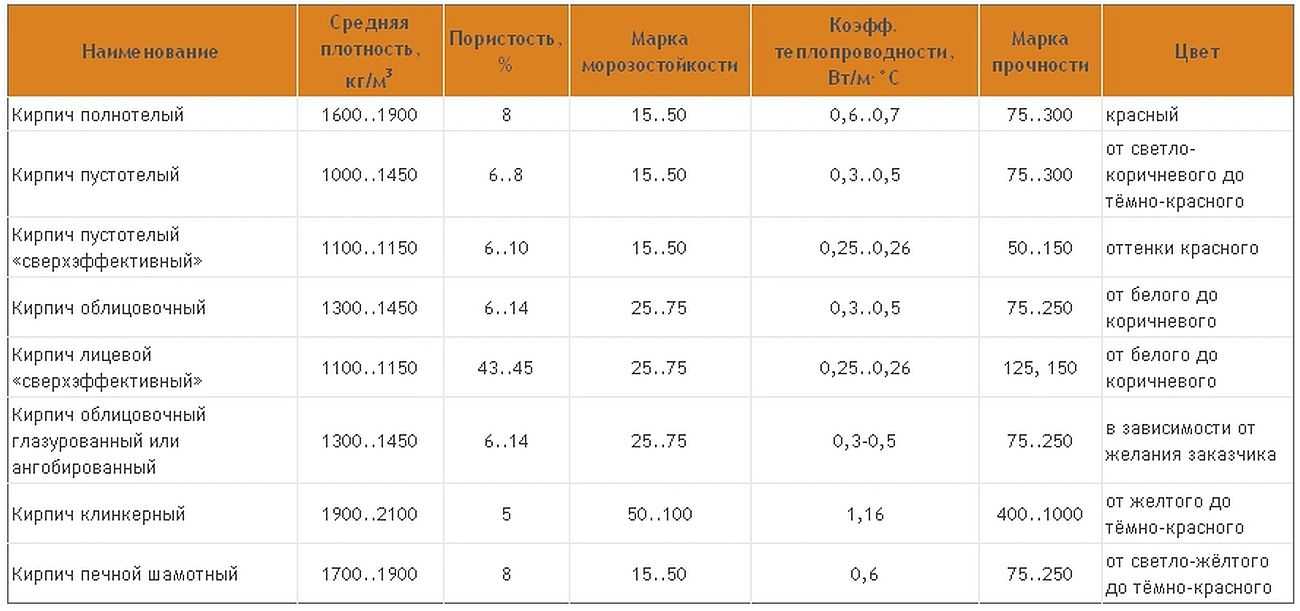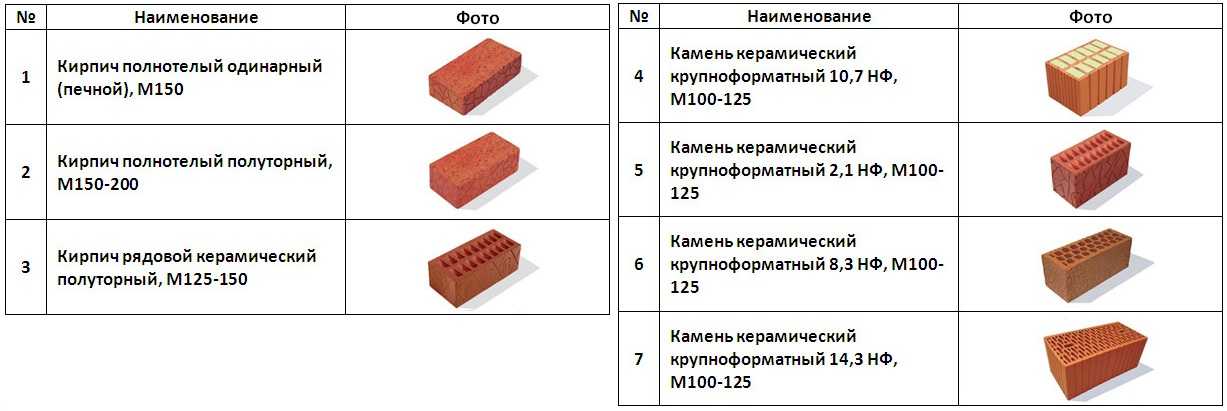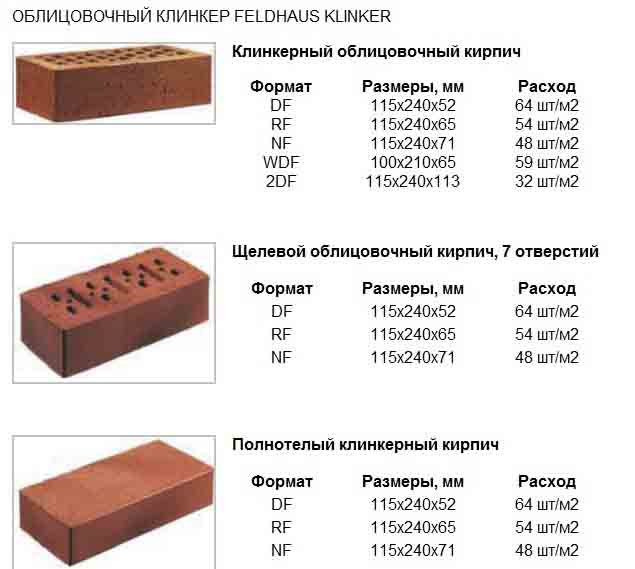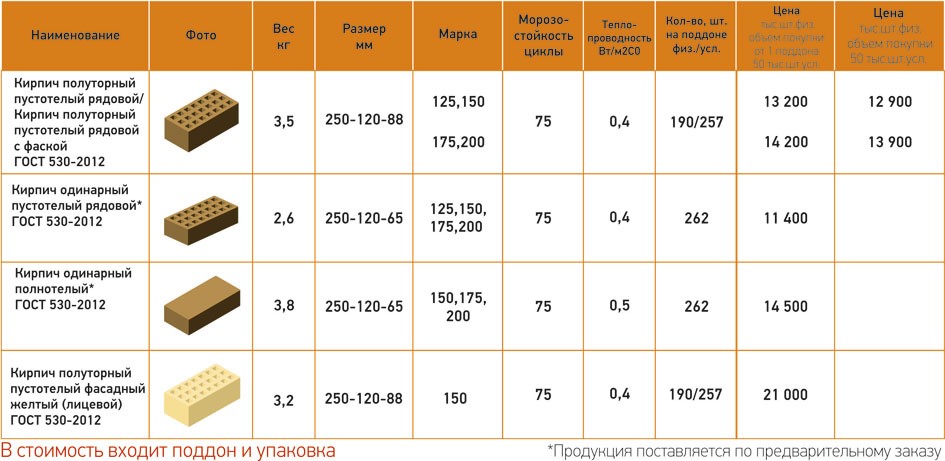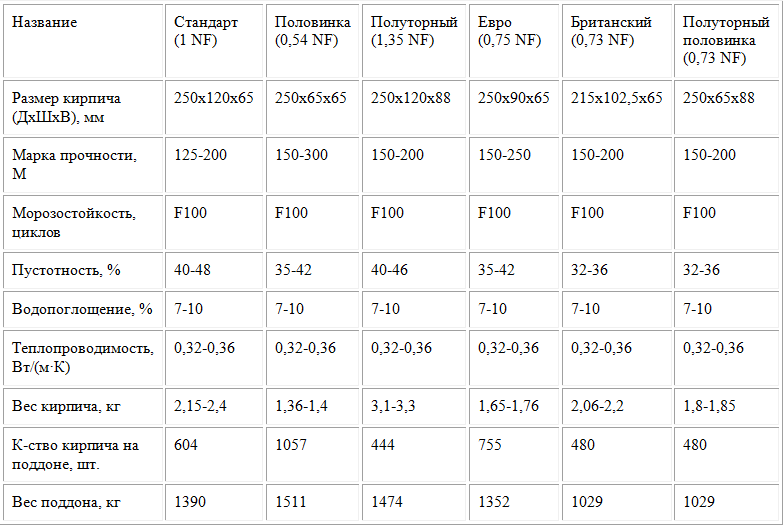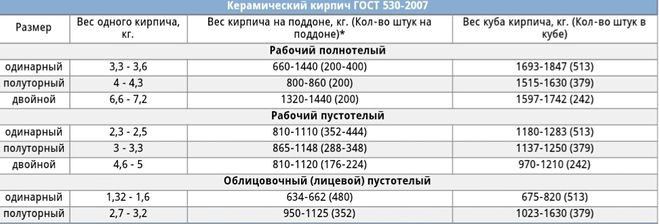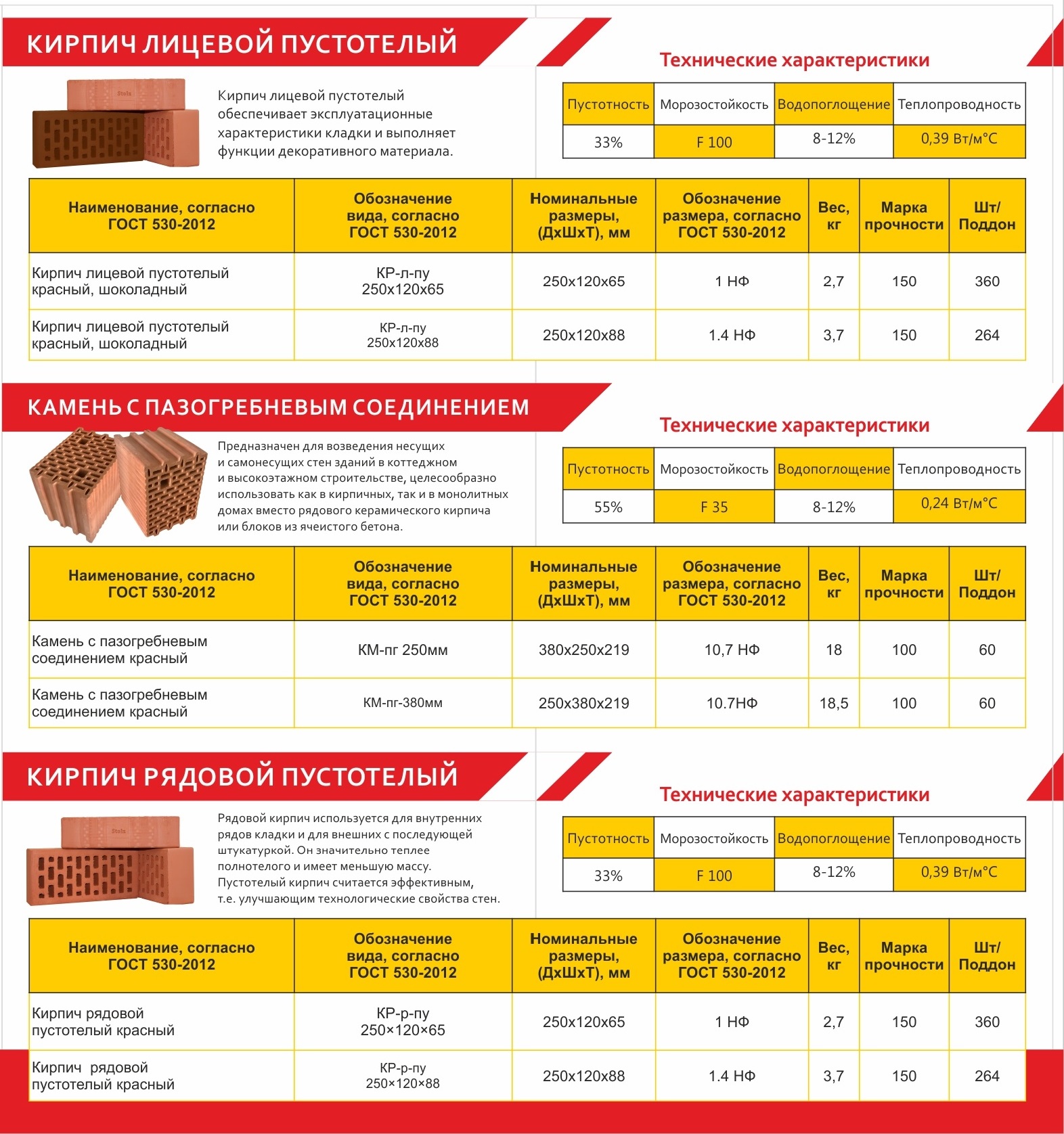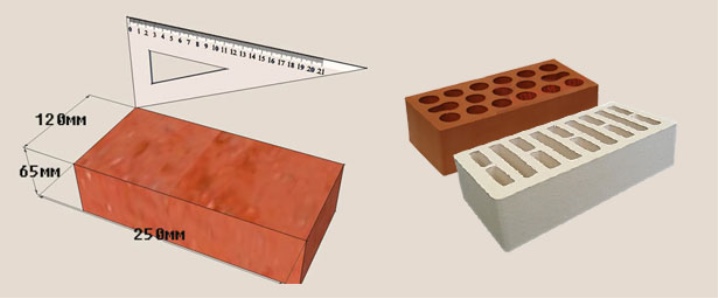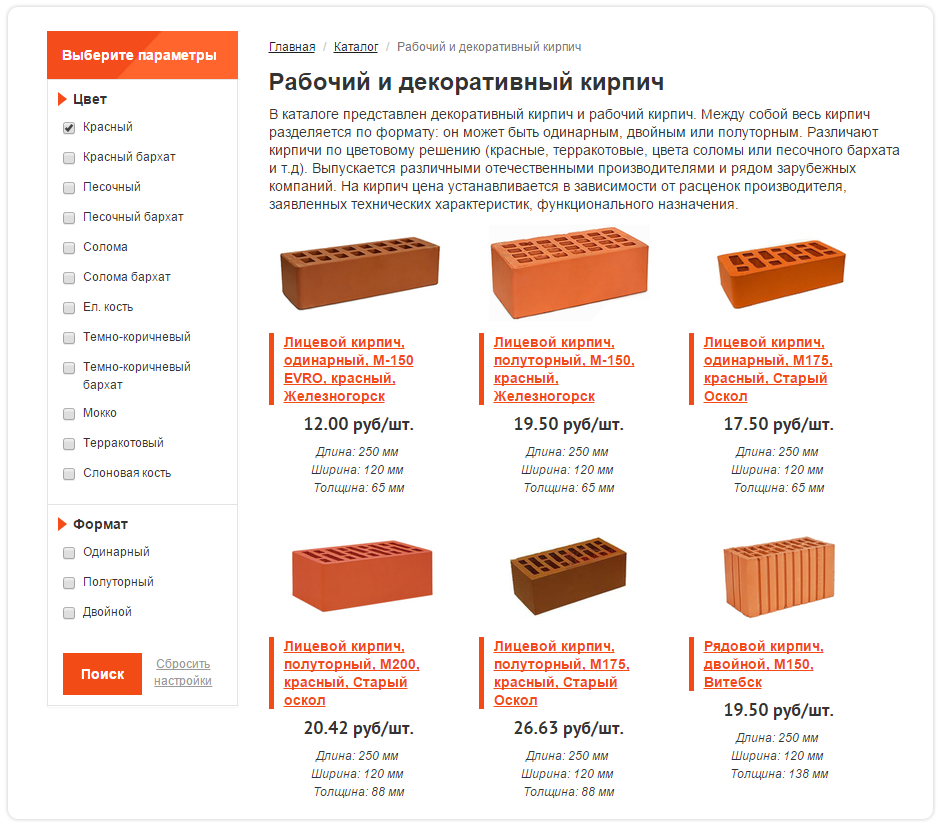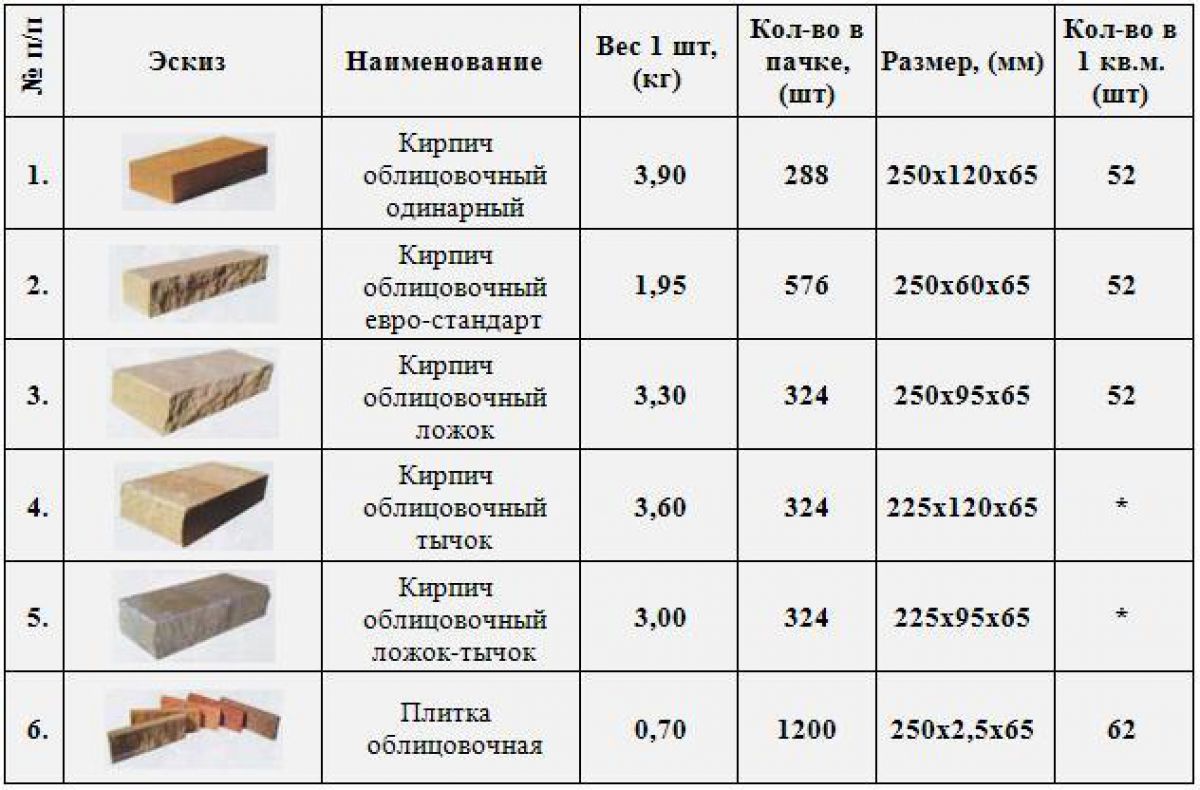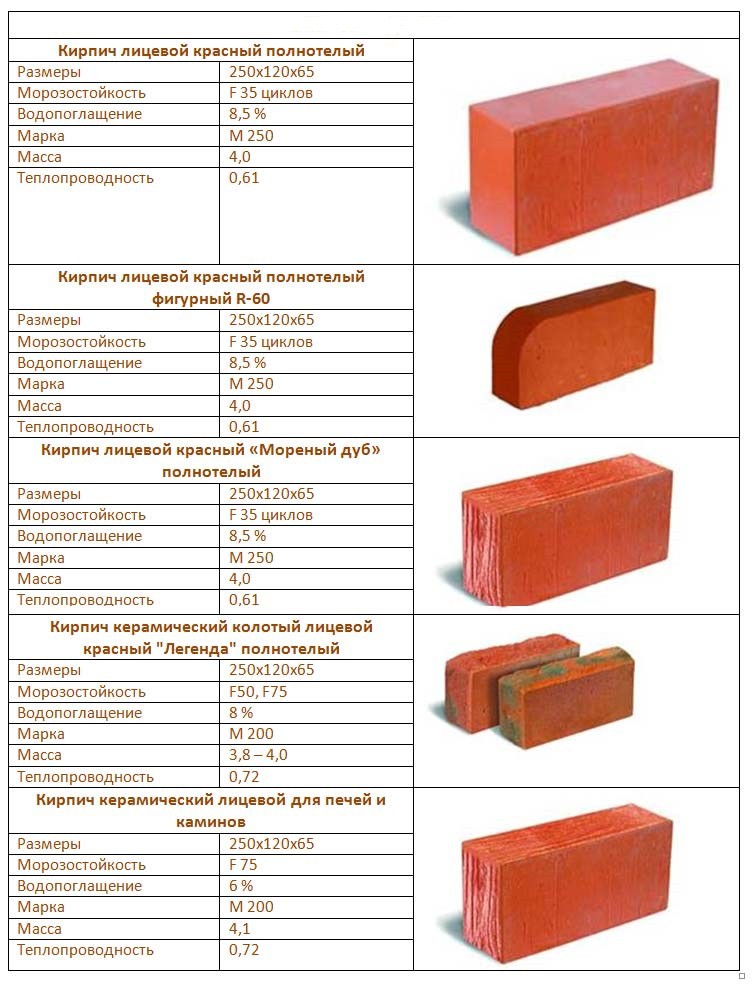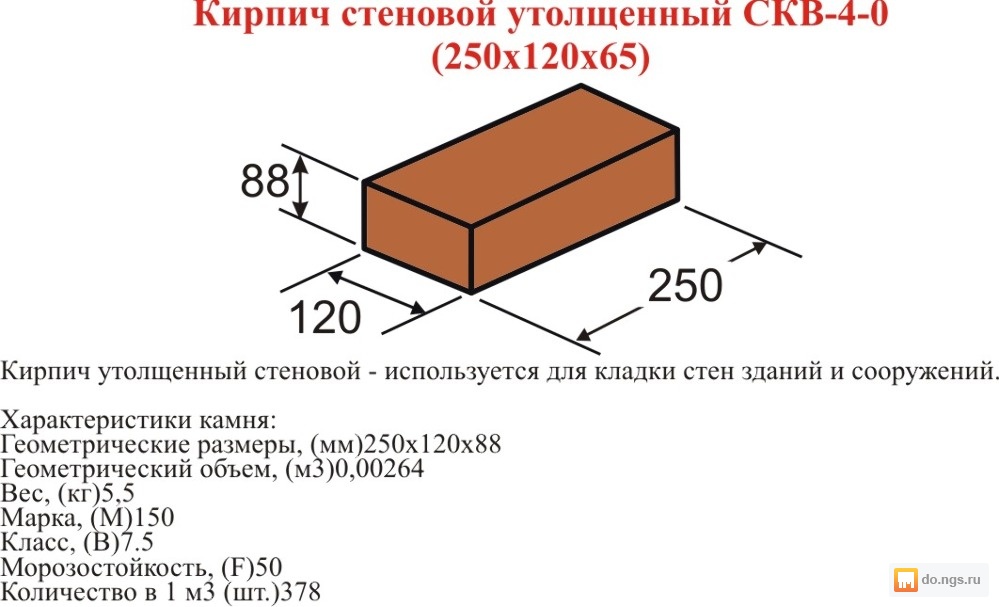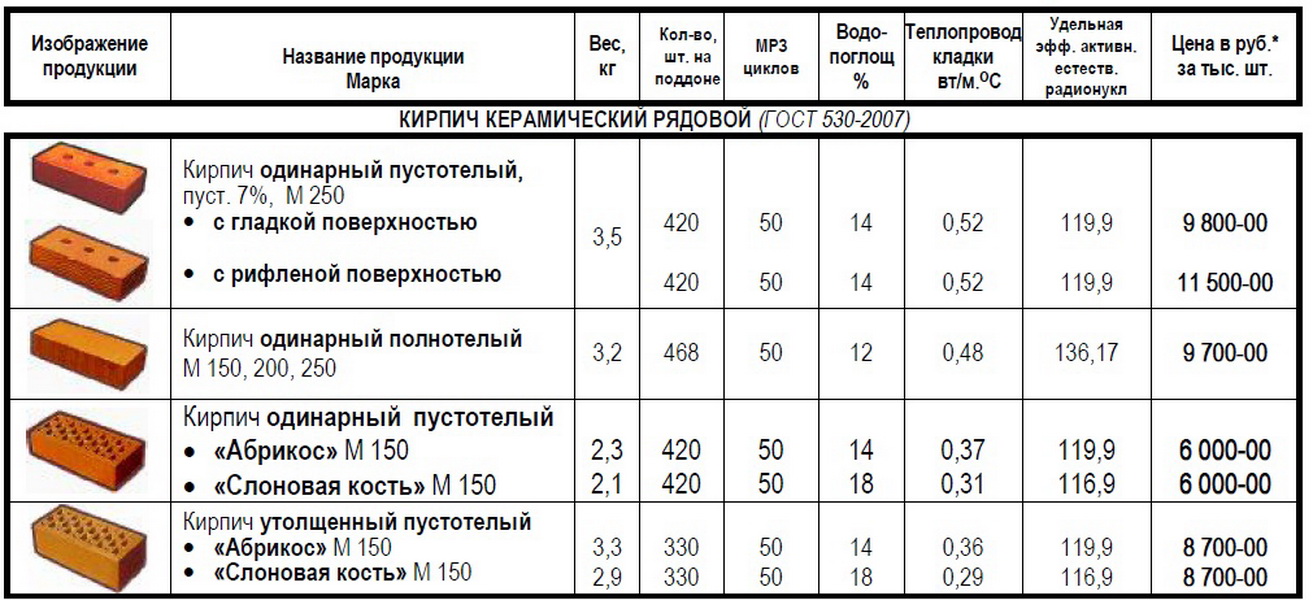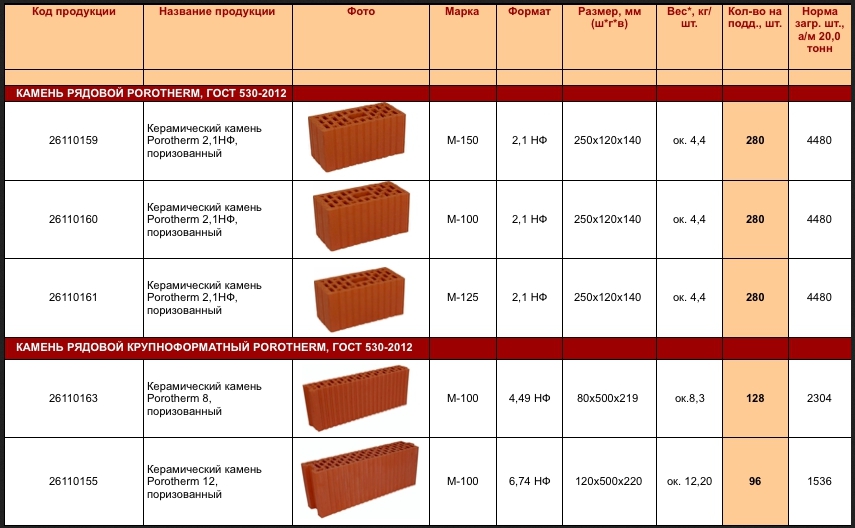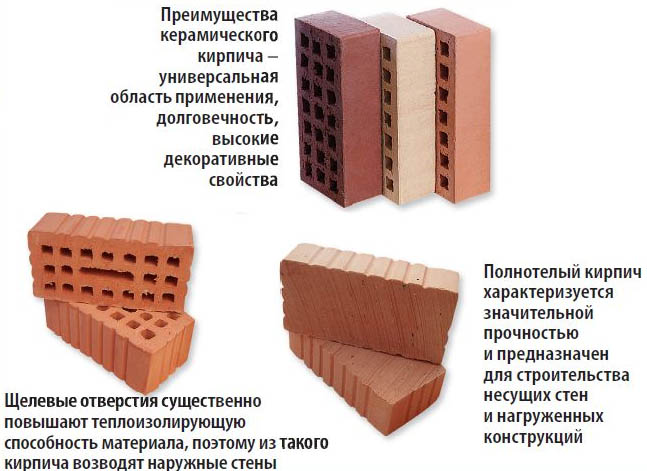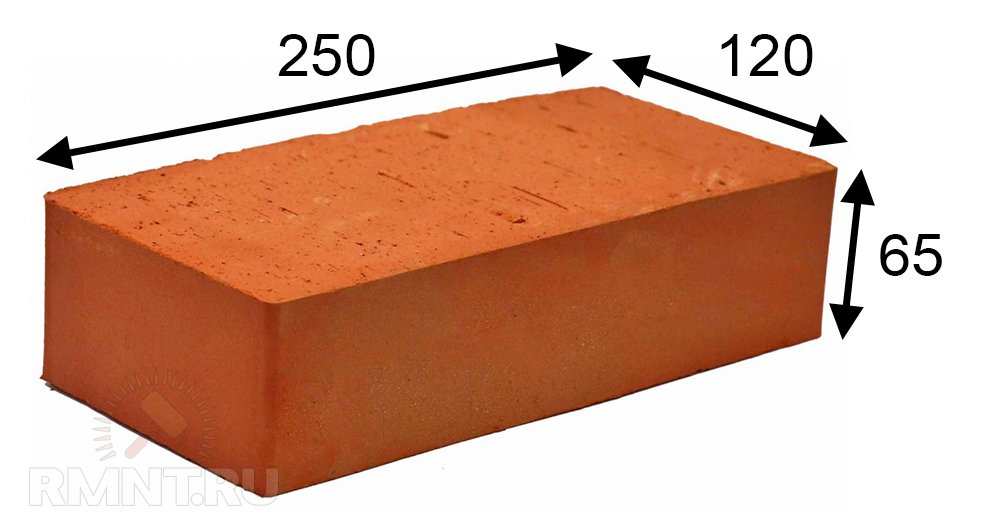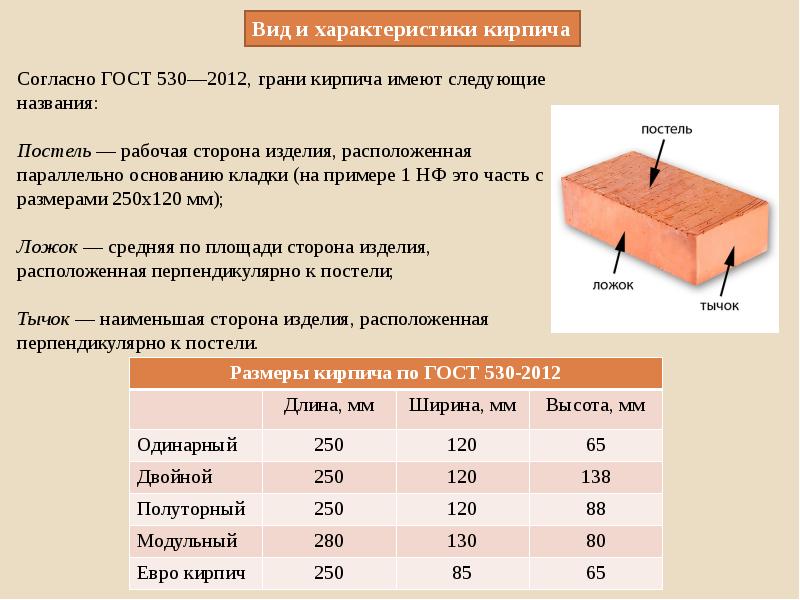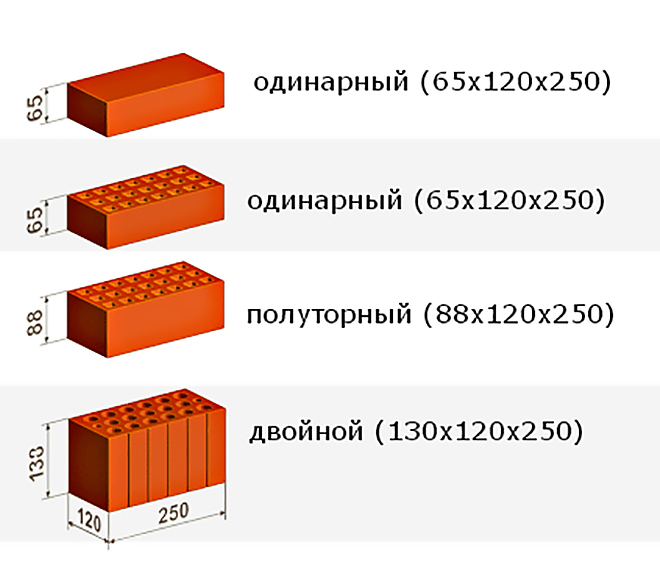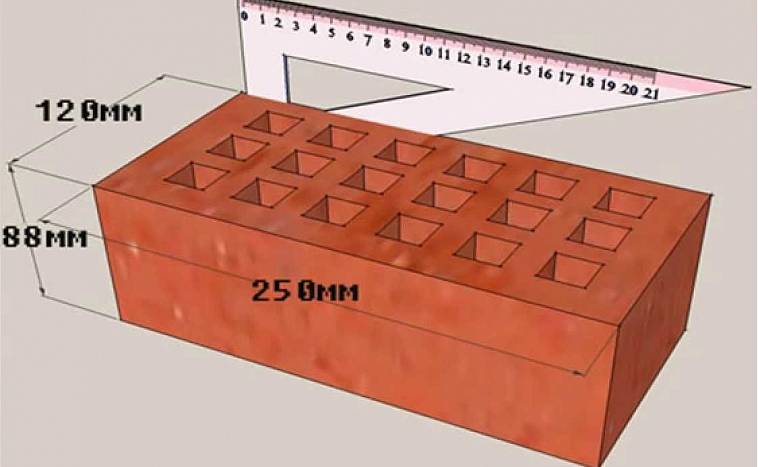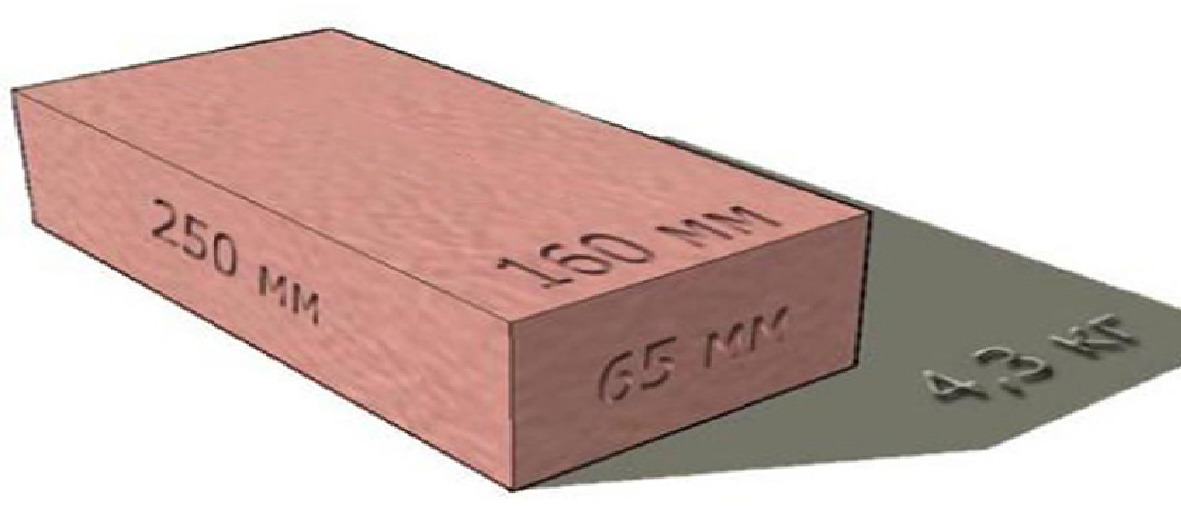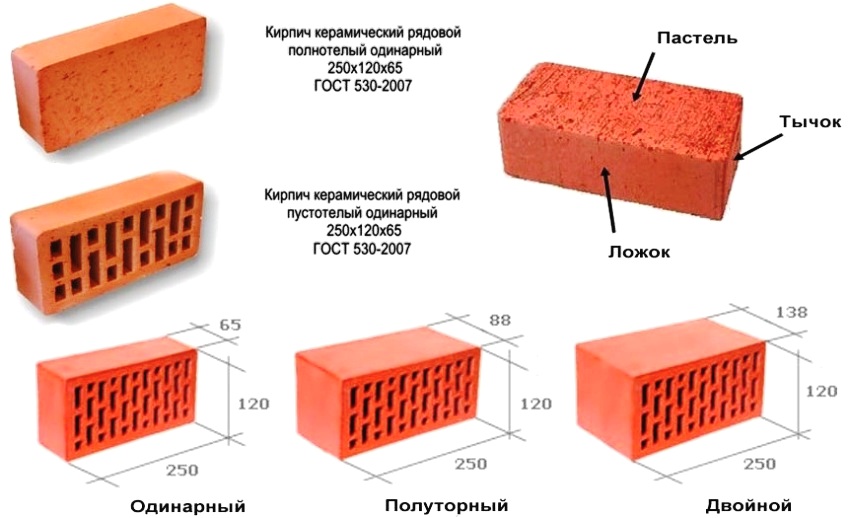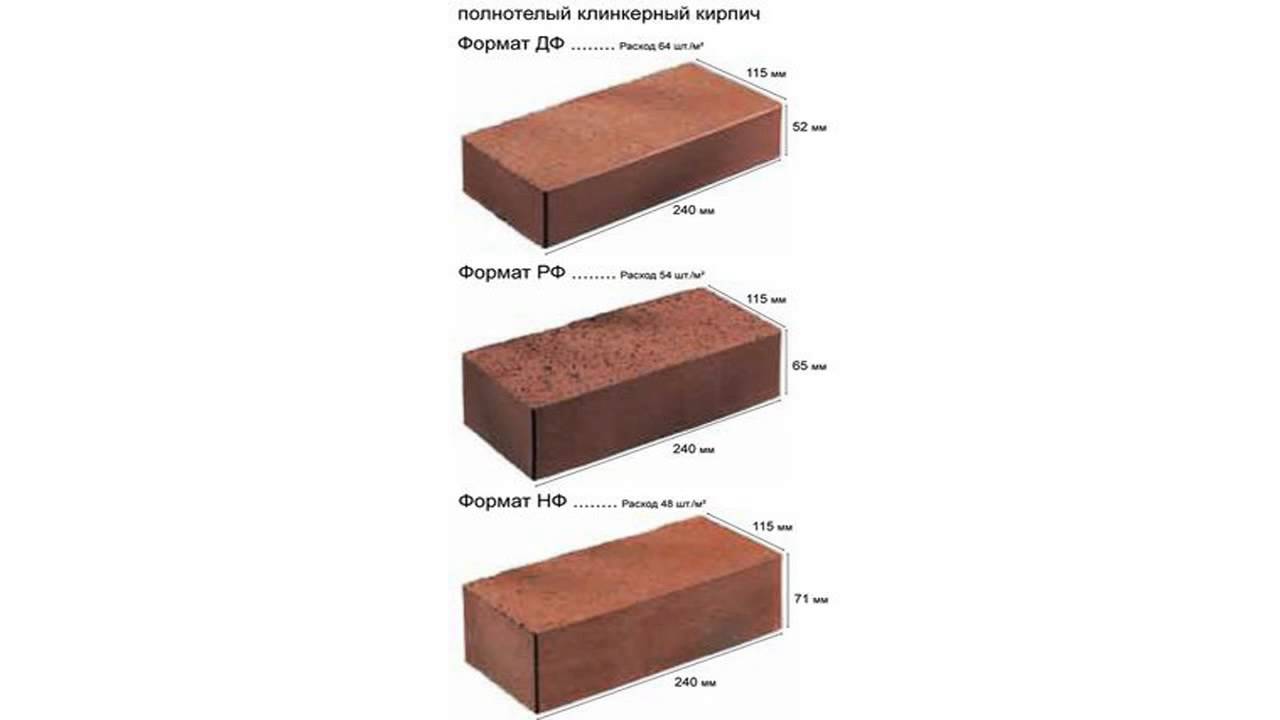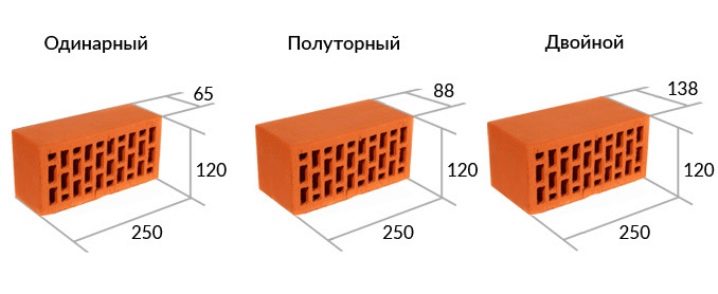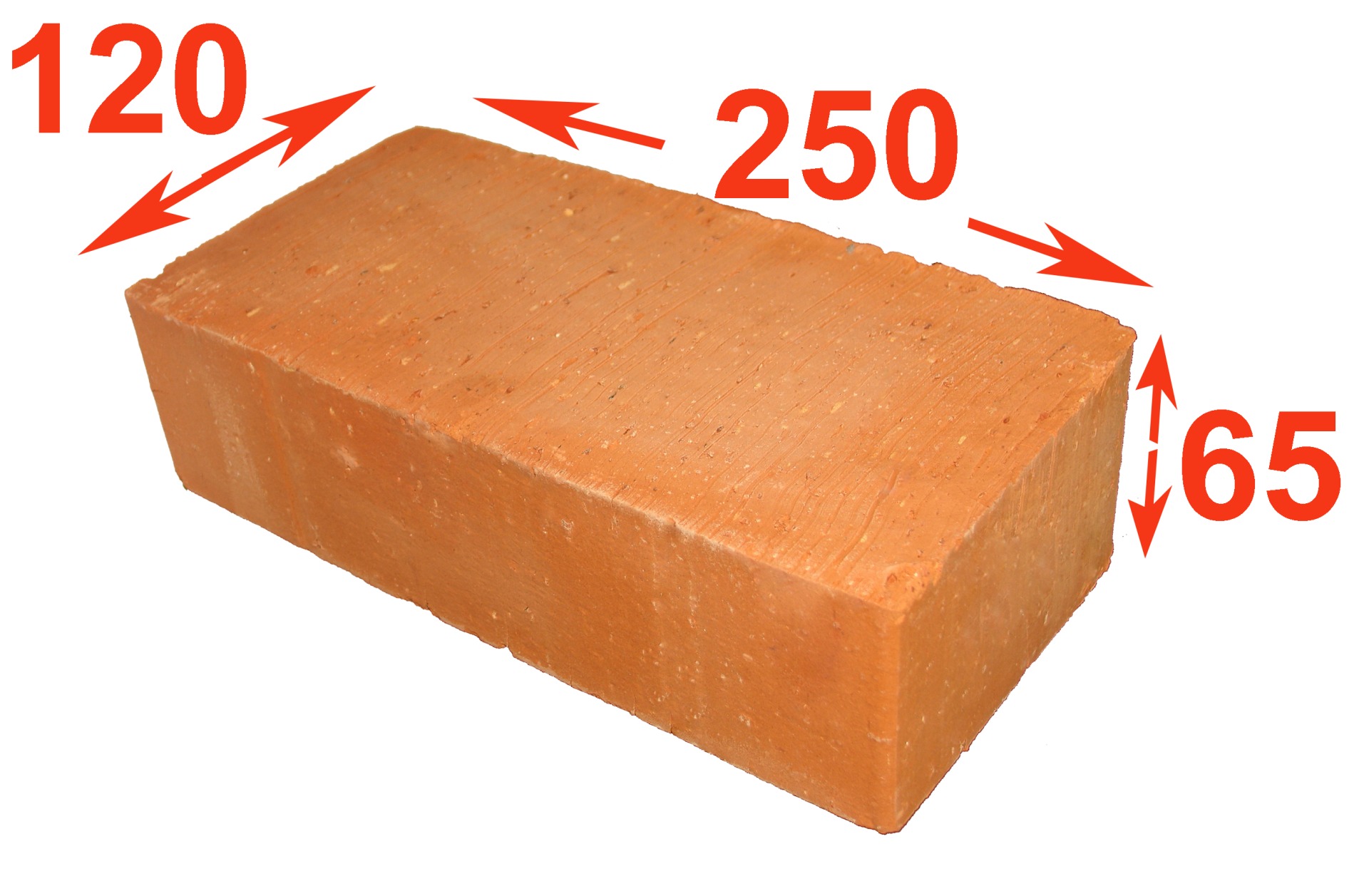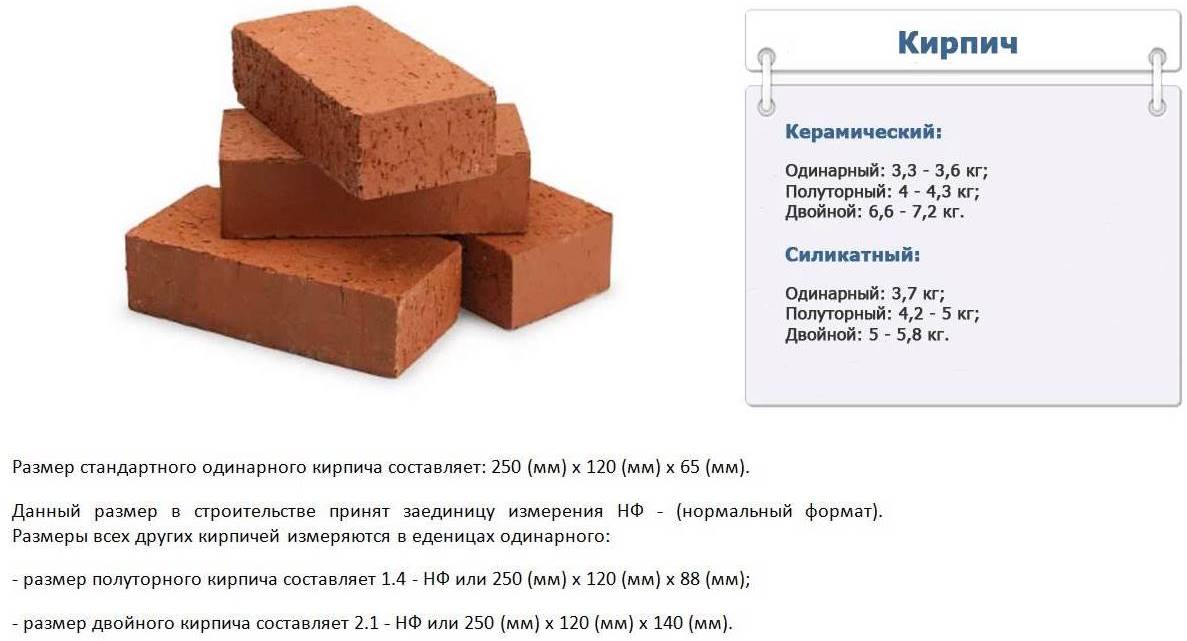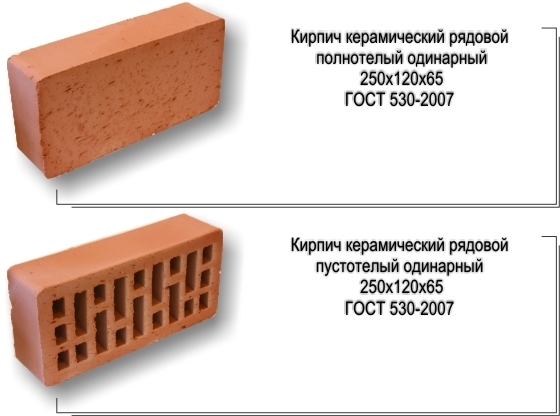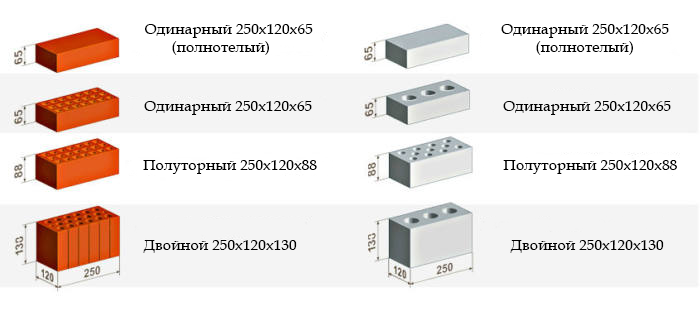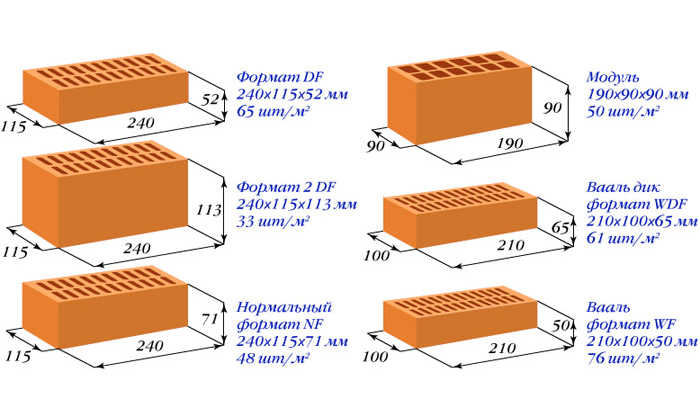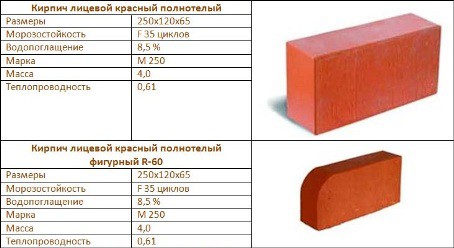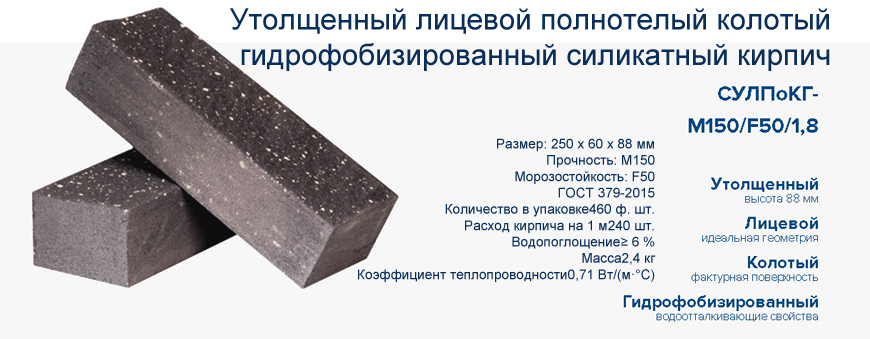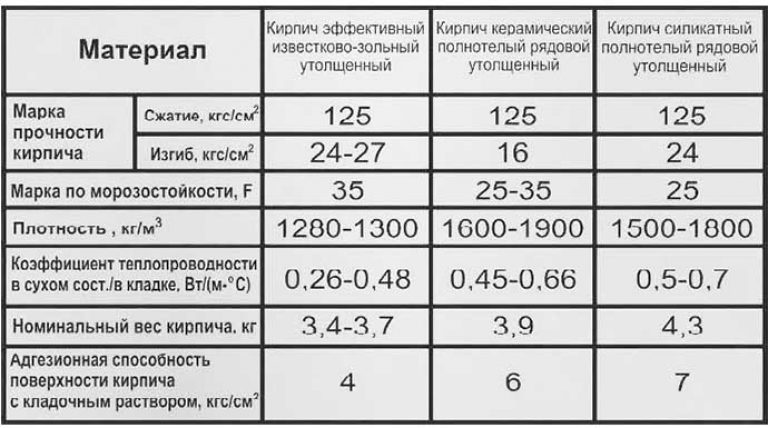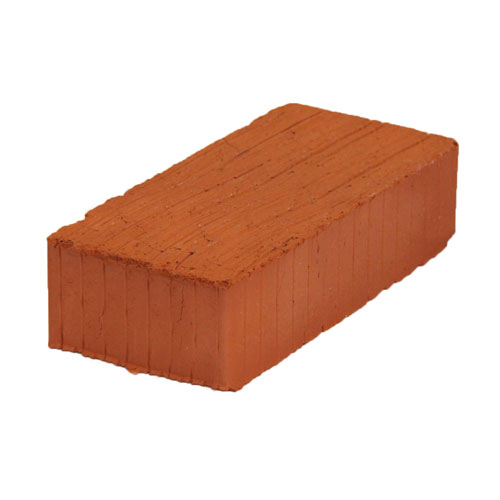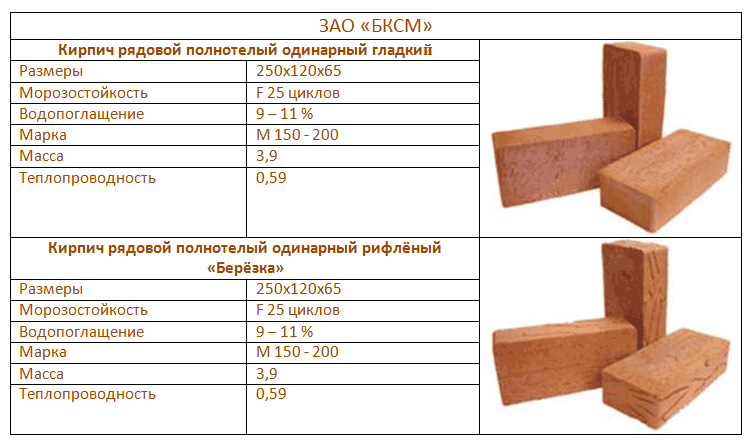Types and characteristics
Traditionally, the classification of building blocks is based on their size and shape, the density of ceramic bricks and even the type of surface. Let's consider the main parameters by which their separation is most often performed.
1. Density (emptiness).
The characteristics are largely due to the internal structure. It is quite possible to judge about them, knowing only the density of the blocks:
- The lowest voidage rate (5%) is in the ultra-strong clinker, which is produced under brands from M400 to M1000. The minimum number of pores provides it with increased frost resistance - from 50 to 100 cycles.
- The density of solid bricks ranges from 1600-1900 kg / m3. With a porosity of 8%, it is possible to obtain stones up to the M300 grade with quite decent values of frost resistance F15-50.
- Facing materials are much lighter and can have a fairly wide range of porosity values from 6 to 14%. Because of this, the strength characteristics suffer somewhat, which do not exceed M250.
- Density of the hollow product. The structure of the blocks itself may not differ from the row or even approach a strong clinker (6-8%), so that the brand remains unchanged. But due to the presence of technological holes in the body, the weight decreases and the thermal insulation capacity improves.
In total, 6 classes of building blocks were identified with density indicators from 0.8 to 2.4 t / m3. This separation greatly simplifies the calculations in the design of objects when it comes to loads and thermal protection of walls.
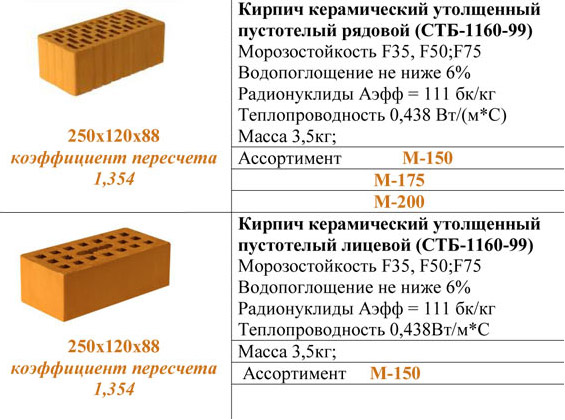
Other technical characteristics are approximately the same for all types of red bricks:
- Water absorption is normally 8%, but this figure can vary within 6-14%.
- Air permeability - 0.14-0.17 mg / m · h · Pa.
- Shrinkage of blocks in masonry - from 0.03 to 0.1 mm / m height. These numbers are considered small, which is why brick structures are less susceptible to cracking than others.
2. Heat insulating properties.
If problems arise with this point, a decision is made to use hollow blocks in construction. They are distinguished from ordinary ones by the presence of through or blind slots, round or rectangular holes. Due to a decrease in the amount of raw materials, their price turns out to be lower than for solid ceramic bricks, and the insulating characteristics of stones are higher, this practically does not affect the strength.
The thermal conductivity of the blocks also allows them to be classified according to their efficiency, dividing them into 5 types. The best indicators are for the lightest products with a specific gravity of 0.7-1 t / m3.
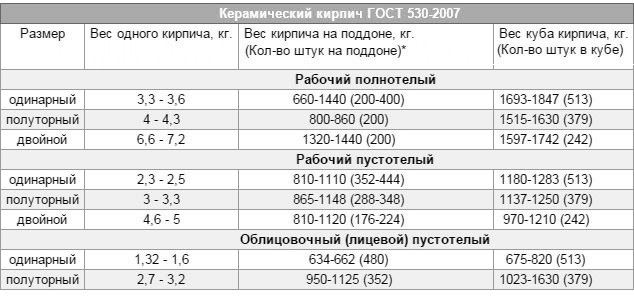
For such a classification, a single corpulent GOST brick is taken as a basis. It has a good aspect ratio with ideal multiplicity, allowing you to stack standard stones in any order without any problems. Even the centimeter seam tolerance is taken into account. The 1NF format is considered the standard (250x120x65 mm).
All other types are already with a change in one of the linear parameters:
- 0.7NF - "euro" with a width of 85 mm.
- 1.4NF - one and a half (thickened to 88 mm).
- 2.1 NF - double has dimensions of 250x120x140 mm.
- 1,3 NF - modular. Here, only the thickness remained standard, and the bed increased to 288x138 mm.
According to GOST 530-2012, the linear dimensions of the brick may have a slight deviation from the standard within 3-4 mm.

How much does a silicate brick weigh?
Silicate brick belongs to the category of artificial building materials for the construction of vertical enclosing structures. The characteristics are excellent, the scope of application is wide, but do not forget that the type of foundation or supporting elements depends on such a parameter as the mass of white brick.Therefore, even for the simplest calculations, you need to know the weight.
Types and characteristics
White brick is produced by a non-fired method from a mixture of lime binder, silica filler (quartz sand, fly ash, sludge, etc.) and a small amount of water to moisten the mixture. In production conditions, raw materials are pressed and autoclaved. Due to this, the finished block gains the required parameters:
1. The compressive strength is marked with the M75-M300 brand.
2. Thermal conductivity - up to 0.87 W / m * K.
3. Frost resistance: withstands from 15 to 50 complete freeze-thaw cycles when fully immersed in water.
4. Density: porous or lightweight up to 1500 kg / m³. Products with an index exceeding this indicator are called dense.
5. Water absorption - 6-16%.
Plants produce a silicate block of the following dimensions:
- Single: 250x120x65 mm.
- One and a half or thickened: 250x12x88.
- Double: 250x120x103.
- Embossed: 250x90x65.
By the field of application, a distinction is made between working or ordinary brick and facing. The latter is used for finishing facades, foundations, basements, fences.
The structure for all sizes is typical:
- full-bodied or monolithic product;
- hollow products, with a void content of up to 15% (3-void), 25% (11-void) and 31% (14-void).
White brick produced in accordance with GOST 379-95 "Bricks and silicate stones" must have a standard weight according to the table below.
The data from the table are corrected for the weight of auxiliary materials. That is, for example, the weight of one one-and-a-half solid silicate brick made according to the basic recipe from lime and sand is 4.2 kg / pc. The total weight of the building material laid on the Euro pallet is 840 kg, but the pallet itself, protective film and fixing straps are added to this. Accordingly, the cargo prepared for transportation will weigh approximately 846 kg.
The weight of a hollow silicate block 250x120x88 is less than a solid analogue precisely due to the cracks, but during the construction process they will be filled with mortar, so the total mass of the masonry will increase significantly. This must also be taken into account when calculating the project plan.
Before buying, you need to carefully inspect the proposed product. The surface must be firm, even, free of chips, chamfered corners, cracks and cavities. If the product crumbles in the hand, slightly crumbles, it means that it was overdried or underdried, therefore it is not suitable for the construction of walls - it will quickly collapse.
White silicate bricks, along with red ceramic bricks, occupy a worthy place in the category of building materials for fencing.
Before starting any type of construction, you need to accurately calculate how much consumable material, including.
With the advent of new building materials, which significantly speed up and reduce the cost of construction of buildings, but do not have.
Dimensions according to GOST
Corpulent brick m100 is produced in different sizes. They have a ratio of length, width and height in a ratio of 1: 2: 4. In the selection process, the dimensions of the bricks are selected depending on the intended type of masonry. According to existing standards, the following types are distinguished:
- single (250x120x65 mm);
- one and a half (250x120x88 mm);
- double (250x120x138 mm);
- modular (280x130x80 mm);
- Eurobrick (250x85x65 mm).
The dimensions that distinguish a single ordinary brick allow you to lay any desired width of the walls. Versatile characteristics provide for masonry walls or walls from 6.5 cm to 65 cm and more.
Possible deviations from standardized dimensions cannot exceed 4 mm in length, 3 mm in width, 3 mm in thickness. The curvature of the surfaces of edges and edges within 3 mm is allowed.
Standard brick sizes.
Cracks must not be deeper than 30 mm. A brick certificate is important, you should not buy material without documents for it.
Single brick weight is approximately 2-2.3 kg. One and a half weighs 3-3.2 kg. The weight of the double is 4.8-5 kg.
Dimensional characteristics are important when calculating the required amount of material for various types of construction and repair work. The required volume is easily calculated thanks to the knowledge of the standard sizes. Variations in dimensions must be taken into account when calculating material consumption.
Refractory brick characteristics
Given the variety of types of fireclay refractory bricks, this subspecies is stronger. The dimensions of fireclay bricks depend on the marking, and are also used when laying buildings.
In addition, this product stands out for:
- insignificant weight;
- excellent thermal conductivity;
- reliability;
- decorativeness.
All brick sizes, even those made by different manufacturers, are made to the standard.
Including all the listed characteristics, building materials are only of the highest quality.
Depending on the type of product inclusions, the method of firing and the purpose, the building material is divided into the following types:
quartz (composed of quartz sand, clay). Here is the formula of quartz sand;

Quartz
fireclay (produced by the method of burning fireclay powder and clay raw materials);
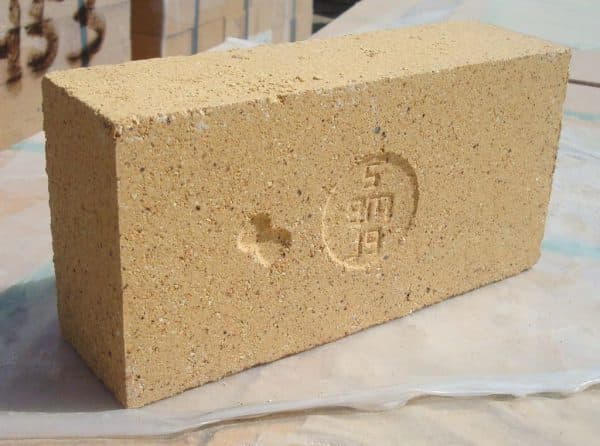
Chamotny
the main one is a red brick based on clay inclusion. Check out its dimensions here;
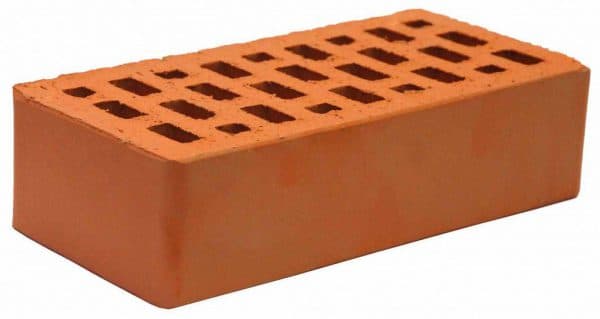
Red
white silicate. Here is its texture;
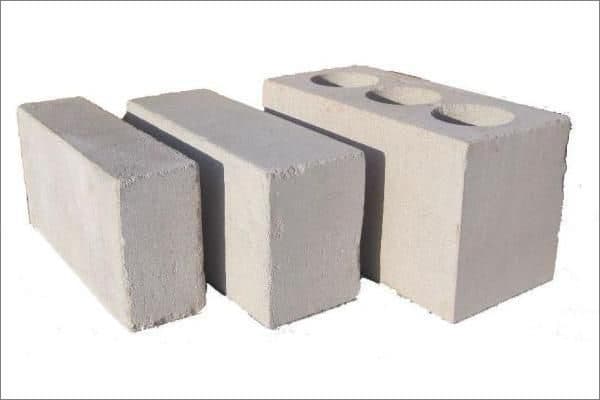
White silicate
carbonaceous (pressed graphite).
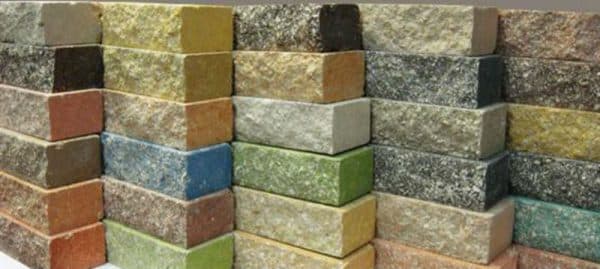
Carbonaceous
Basic and carbon types are used in industrial companies, withstanding significant tºC. For home stoves, a chamotte product is used.
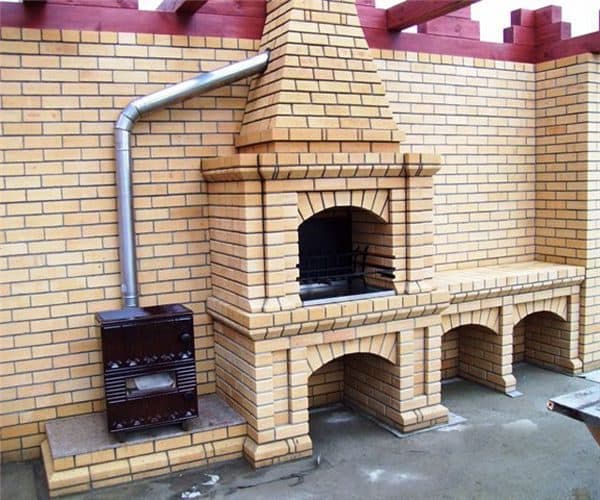
Home oven
The quartz product is excellent at keeping tºC, however it breaks down under chemical conditions. Straight, angular, wedge-shaped brick formations are used in the building.

Different shape
Choosing a brick of excellent quality, you can not worry about the durability of the building. Each type has its own labeling and scale. It is impossible to combine types of refractory bricks together to fit a universal size.
The first standard originated in the Russian Federation in 1927. We were guided by a German product with scales of 250x120x65, which have remained to this day, are fixed as standard sizes.
This size is usually considered as NF - normal format. Used red brick for the construction of the base of the walls, with their further processing.
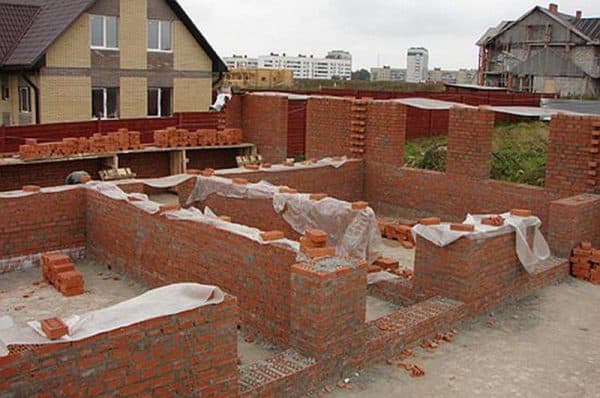
Walling
There are several types of building material:
- single is referred to as a common choice in construction. The dimensions of a single red brick are 25x12x6.5 cm;
- one and a half arose in the era of industrialization already on an increased scale. The size of the one-and-a-half facing, as well as the building one, is 25x120x8.8 cm;
- double size of refractory bricks GOST standard appeared later 25x12x13.8 cm.
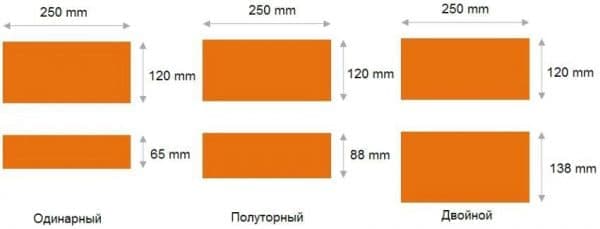
Dimensions (edit)
The size of the fireclay brick and other indicators are described in the article.

Euro Euro
According to the standard, the facets have the name poke, spoons, bed. The wide side is the bed. The short edges are called “pokes” and they determine the height. The long, narrow edge is the spoon.
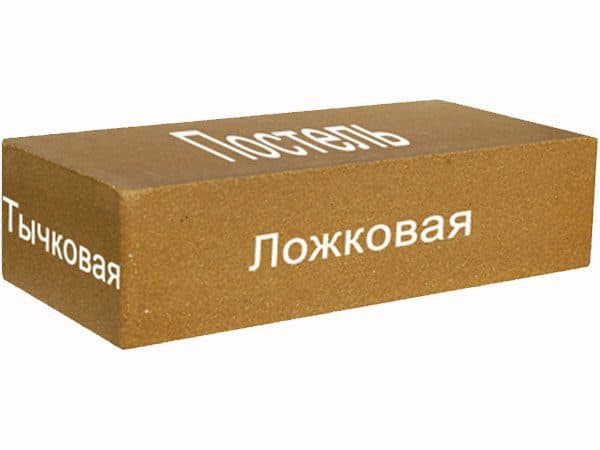
Names of the parties
Brick panels look great as an external treatment. The correct size makes construction work easier.
Technical characteristics of solid bricks
This brick in its structure and basic parameters differs significantly from ordinary counterparts, the disadvantage of which is the presence of voids and some porosity. The main technical characteristics of solid bricks and at the same time its advantages over other similar products are as follows:
Standard sizes of single solid bricks.
- increased strength;
- high density;
- frost resistance;
- relatively low thermal conductivity;
- low porosity;
- slight water absorption.
The specified parameters in the best possible way make it clear that the use of solid bricks will be the most optimal solution aimed at giving the finished object excellent strength and durability. The technical characteristics of this product once again emphasize the uniqueness of such products. At the same time, the mass of one brick unit ranges from 3-4.5 kg, which is almost twice the weight of an ordinary hollow product. The dimensions of solid bricks according to GOST standards are 250x120x65. The dimensions are indicated in the corresponding technical documentation accompanying this ceramic product; this is a prerequisite for its release from the manufacturer. However, some varieties of corpulent material can be characterized by fundamentally different parameters - the thickness and height of the product.
Basic elements and colors of the material
According to GOST, introduced in 2007, product planes have the names:
The name of the sides of the brick.
- bed;
- spoons;
- jab.
The bed is a plane with dimensions of 250x120 mm (image No. 1). The spoon has dimensions of 250x65 mm. The length of the butt is 120, its width is 65 mm. The material itself has been used since ancient times. Technology has improved over time. This led to the emergence of new varieties of material. But its dimensions remained unchanged. Knowing them, you can calculate the number of items in the masonry.
The requirements for the construction of buildings were constantly growing, which led to the creation of new materials. The size of an ordinary brick 250x120x65 mm today has a European marking - RF, although the eurobrick has slightly different dimensions - 250x85x65. The most popular bricks in Europe are marked with NF (normal). These are blocks of 240x115x71 mm. There is a material of 240x115x52 mm. It is marked DF (thin). Blocks of 200x100x50 mm are in less demand. On the modern market, you can buy blocks 50 cm long.
Image 1. The size of a single brick.
The density of the brick depends on whether it is solid or slotted (hollow). The weight of the finished product also depends on this indicator. A solid building block may have some defects:
- chips of a long rib (1 or 2 pieces) with a size not exceeding 1.5 cm;
- curvature of edges or edges up to 3 mm;
- spoons can have a crack along the block width up to 3 cm.
Hollow brick (image No. 2) may also have some tolerances:
- up to 2 bumps, the length of which can reach 1.5 cm if they do not reach the internal cavities;
- cracks in the bed, which can extend to voids;
- 1 crack on the spoon and on the poke.
According to the architectural concept, it is sometimes required to use standard sizes of bricks of different colors. The construction market offers to purchase materials of many shades and textures: this is artificially aged stone, texture options, variegated brick (image No. 3).
Image 2. Types of semi-wall bricks.
One-and-a-half and double-sized stones are usually produced in a hollow version. Internal cavities reduce the density of the brick. Its mass is significantly reduced. The weight of the entire structure is also reduced.
The type of material for manufacturing allows you to divide finished products into types:
- ceramic (red);
- silicate (white);
- clinker;
- fireclay;
- facing.
Ceramic building material is obtained after firing pressed clay briquettes. Such material is used in the construction of walls and foundations, partitions and fences, when laying household stoves. Block grades can be from 75 to 300. These numbers indicate the pressure that 1 cm² of material can withstand in kilograms. Density of 1 m³ (480 pieces) - 1700 kg.
Image 3. Variety of bricks.
The base of the white block is silicates. They are softer and lighter than ceramics. But the strength of such a product is lower than the red analogue. The block consists of sand, which occupies 90% of the total mass and lime (10%). By adding a small amount of coloring pigments, a colored material is made.It is used for the construction of partitions and entire walls, when facing buildings. Its use is not recommended for laying foundations and plinths. White brick is not suitable for laying stoves and fireplaces.
Clinker bricks are distinguished by their high strength and low water absorption. It is an excellent decorative material that is not afraid of temperature extremes and precipitation.
Fireclay brick belongs to refractory grades. In everyday life, the material of the Sh brand is used. These are:
- Ш-5 with dimensions 230х114х65;
- Sh-6 - 230x115x40;
- Ш-8 - 250х124х65.
The facing block is smooth, chopped and imitating a wild stone. Its dimensions in millimeters:
- 290x140x85;
- 250x120x88;
- 250x80x65;
- 250x60x65;
- 250x120x65.
Products for facing works can also be wedge-shaped. They are used for laying vaults and arches. Their curvature is different. Ш-22 - wedge block with dimensions 230х114х65 / 55 mm. The front wedge of the Sh-45 brand has dimensions of 230x114x65 / 45 mm.
Red brick, sizes and varieties and defects
The dimensions of ordinary red brick are standardized by the requirements of GOST 530-2007, products are produced in the following standard sizes:
- Normal format, it is also single, the dimensions of an ordinary red brick are 250 × 120x65 mm;
- One and a half, thickened, in this case the thickness is increased, the remaining dimensions remain the same - 250 × 120x88 mm;
- Double, large format, overall dimensions - 250 × 120x138 mm;
- Modular, normal format, overall dimensions 288 × 138x65;
- "Euro" - a standard that came from Europe, has several types, the most famous size is 250 × 85x65 mm, this standard is also spelled out in GOST.
It should be noted that GOST allows the execution of bricks with deviations from the standard. Therefore, the dimensions of the red brick may differ slightly from the control dimensions.
 "Effective", it is a hollow brick, the structure of ceramics is clearly visible
"Effective", it is a hollow brick, the structure of ceramics is clearly visible
Separately, it is necessary to note wedge-shaped products intended for the assembly of vaults and arches, this type of product is heat-resistant, and has a narrowed shape along the edges.
 Kiln Wedge Brick
Kiln Wedge Brick
Dimensions of standard red brick
The dimensions of this building material are fully regulated by GOST, the height of the red brick can change depending on the operating conditions and its purpose, within the limits and sizes provided for by the system of state standards.
The dimensions of the hollow and the dimensions of the full-bodied red brick are similar, in this regard, only the scope of their operation differs.
Slotted or hollow, is actively used to fill openings in monolithic and frame structures, to assemble walls, create partitions, while a corpulent one is operated under high loads: the foundation of a house, basements, load-bearing walls.
Dimensions of red facing brick
Facing or facing bricks are used for outdoor laying, decorative finishing of the walls of structures. The design and size of the facing brick is selected based on the project.
The size of a single facing brick is completely similar to the standard size - 250 × 120x65 or Euro 250 × 85x65 mm.
 Dimensions and designations
Dimensions and designations
Dimensions of oven red brick
A stove brick, from an ordinary one, is distinguished by the ability to endure the effects of an open flame and high temperatures for a long time, the area of its operation is the creation of devices operating with high temperature loads, the lining of such structures and equipment operating under the influence of an open flame. Distinguish between refractory red and fireclay bricks.
The price of a red oven brick is usually higher than that of an ordinary one. This is a result of the fact that other raw materials and technologies are used for the manufacture of these products.
The overall size of the oven brick, unlike other types, can be conditionally divided into two types:
- Rectangular products with the dimensions of single and thickened bricks 250 × 120x65 mm and 250 × 120x88 mm;
- Wedge-shaped products according to GOST 8426-75, products of a special shape: distinguish between radial-longitudinal and radial-transverse.
Red brick for the foundation, dimensions and features
For laying a foundation, a brick must have increased moisture resistance and reduced water absorption, since the foundation is most susceptible to moisture. The overall size of an ordinary red brick is selected based on the technical requirements of the house project. In addition, the products used for the construction of the foundation must have high bearing characteristics, since the foundation accounts for most of the bearing load of the structure.
When choosing a material for basement floors, you need to pay attention to the choice of material according to physical parameters: frost resistance, moisture permeability, and others. Strength is also extremely important, the product in the masonry will bear the entire weight of the structure
For the foundation, it is necessary to select a high-quality, well-fired material, without defects arising from a violation of the technology of its production and storage.
For the foundation, it is recommended to use an ordinary solid brick. Dimensions - 250 × 120x65 mm single and 250 × 120x88 thickened. The double size of red brick for a plinth is rarely used.
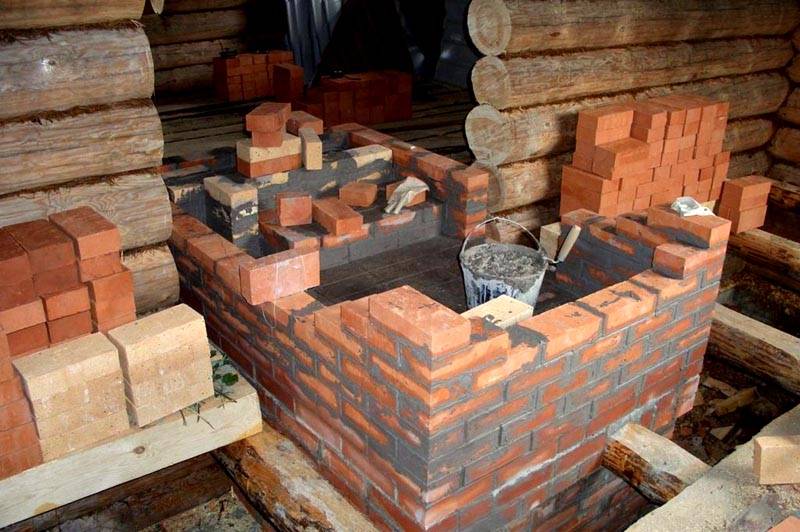 Fold down the oven? Easily!
Fold down the oven? Easily!
What buyers and builders need to consider
According to the requirements of GOST 530-2007, single ceramic bricks are produced only with a size of 250x120x65 mm. A similar material is used if you need to lay out load-bearing walls and a number of other structures. Its severity differs depending on whether hollow or full-weight facing blocks will be laid. A red facing brick that has no voids will weigh 3.6 or 3.7 kg. And in the presence of internal grooves, the mass of 1 block will be at least 2.1 and maximum 2.7 kg.
When using a one-and-a-half facing brick that complies with the standard, the weight is 1 pc. taken equal to 2.7-3.2 kg. Both types of decorative blocks - single and one and a half - can be used to decorate arches and facades. Full weight products can contain a maximum of 13% voids. But in the standards for material including voids, it is indicated that cavities filled with air can occupy from 20 to 45% of the total volume. The lightening of the brick 250x120x65 mm allows to increase the thermal protection of the structure.
Additional Information
All of the above applies to ceramic facing bricks. But it also has a silicate variety. This material is stronger than an ordinary product, it is created by combining quartz sand with lime. The ratio between the two main components is selected by technologists. However, when ordering sand-lime bricks 250x120x65 mm, as well as when buying its traditional counterpart, you must carefully calculate the mass of the blocks.
On average, 1 piece of building material with such dimensions weighs up to 4 kg. The exact value is determined:
-
product size;
-
the presence of cavities;
-
additives used in the preparation of the silicate block;
-
geometry of the finished product.
A single brick (250x120x65 mm) will weigh from 3.5 to 3.7 kg. The so-called one-and-a-half corpulent (250x120x88 mm) has a mass of 4.9 or 5 kg. Certain types of silicate, due to special additives and other technological nuances, can weigh 4.5-5.8 kg. Therefore, it is already quite clear that a silicate brick is heavier than a ceramic block of the same size. This difference must be taken into account in projects, to strengthen the foundation of buildings under construction.
Hollow silicate brick measuring 250x120x65 mm has a mass of 3.2 kg. This makes it possible to significantly simplify both construction (repair) work and the transportation of ordered blocks. It will be possible to use vehicles of lower carrying capacity. In addition, there is no need to reinforce the walls. And therefore, the foundation of the building being built will be easier to make.
The situation is slightly different with hollow products. Such a single sand-lime brick weighs 3.2 kg.Standard packaging includes 380 pieces. The total weight of the pack (excluding the substrate) will be 1110 kg. Weight 1 cub. m. will be equal to 1640 kg, and this volume itself includes 513 bricks - no more and no less.
Now you can consider one-and-a-half silicate brick. Its dimensions are 250x120x88, and the mass of 1 brick is still the same 3.7 kg. The package will include 280 copies. In total, they will weigh 1148 kg. And 1 m3 of silicate one-and-a-half brick contains 379 blocks, the total weight of which reaches 1400 kg.
There is also chipped silicate 250x120x65 with a weight of 2.5 kg. In an ordinary container, 280 copies are placed. Therefore, the packaging is very light - only 700 kg exactly. Regardless of the type of bricks, all calculations must be carried out very carefully. Only in this case will it be possible to ensure the long-term operation of the building.
If you need to determine the weight of the masonry, you can skip calculating its volume in cubic meters. You can simply calculate the mass of one row of bricks. And then a simple principle is applied. At a height of 1 m there are:
-
13 rows single;
-
10 bands of one and a half;
-
7 strips of double bricks.
This ratio is equally true for both silicate and ceramic varieties of the material. If you have to revet a large wall, it is more correct to choose a one-and-a-half or even double brick. It is recommended to start your selection with hollow blocks because they are lighter and more versatile. But if there is already a solid, solid foundation, you can immediately order full-weight facing products. In any case, the final decision is made only by the customers of the construction or repair.
See below for details.
conclusions
To ensure optimal conductivity and heat retention, brick walls should be as thick as possible. Slotted material is a completely different matter.
This ceramic briquette has through holes (regardless of shape), which is why it is as warm as possible, for which there is a logical explanation: from an increase in the number of voids, the thermal conductivity of ceramic bricks increases. And as a result, the walls of it can be as thin as possible.
In addition, a ceramic briquette with slots is much lighter, so it does not load the foundation and basement so much. The standard sizes of bricks are known to every builder, because this indicator must be taken into account. Initially, this must be done in order to correctly calculate the amount of material used.
Therefore, knowing certain numbers, and skillfully substituting them under the formula, you can quickly and accurately determine the amount of funds that will be spent on repair or construction.

